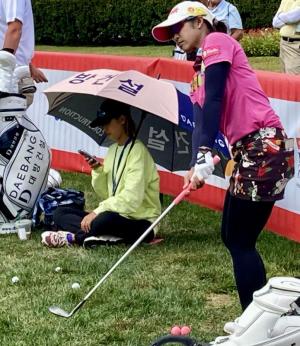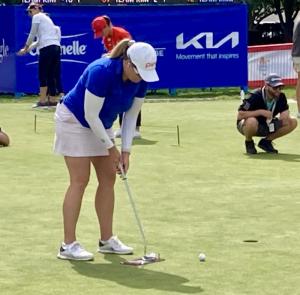If you would like to improve your short game, consider the examples set by the talented members of the Ladies Professional Golf Association.
Finishing a hole in par or better from on the green or just off is what separates most amateurs from the pros.
During the recent ShopRite LPGA Classic, players used different routines to prepare for their next round, or as post-round drills. These methods can also help your game.
Georgia Hall, 2018 Women’s British Open winner, putted underneath a 12-foot length of string stretched between two small stakes that kept the string about a foot off the green surface. One stake stood about a foot past the hole, and Hall putted from about a foot inside the other stake. Using three balls, Hall attempted to sink all three 10-footers, and succeeded several times.
Katherine Perry-Hanski set up eight tees in a spiral pattern on the Seaview putting green. The tees began three feet from the hole and gradually expanded in a counterclockwise direction until the last tee stood about 10 feet away.
Using a single ball, she putted from the three-foot spot, then from four feet, and so on. If she missed a putt, however, she returned to the three-foot tee to begin again.
Even with Perry-Hanski’s undeniable talent, this was a real challenge. Even so, successfully making five or six short putts in a row can do wonders for your confidence.
Matilda Castren of Finland used a simpler technique, with three balls set three to four feet apart in a circle around a hole. Again, if she missed a putt, she started over.
Jackie Stoelting, winner of the 2021 Florida Women’s Open, used an Eye-Line putting trainer. Tees pinned the mirror device to the putting green. Two more tees created a tiny gate through which Stoelting made attempts from four feet away.
She also lined up each ball before taking her stance and making her putts.
Danielle Kang, 2017 KPMG Women’s PGA Championship winner, putted five balls through a similar two-tee gate toward a hole about five feet away. As I watched her, Kang initially kept only her right hand on the grip. As her five-ball sets kept going in without a miss, she eventually switched to a normal two-handed, right-hand-low grip.
By my count, Kang made at least 35 putts in a row.
LPGA veteran Pornanong Phatlum chipped toward a hole about 35 feet from her spot in the light rough on the edge of the Seaview putting green. She had previously placed a tee in the green halfway to the hole.
Phatlum tried to make the first bounce of each chip land as close as possible to that tee, as the balls bounced a few more times and then rolled toward the target. I watched her attempt over 30 of these chip shots.
Kwang Pulsawatch (“Call me KP”) is Phatlum’s caddie and stood behind a hole facing Phatlum. She retrieved and tossed back the pink Volvik golf balls her boss chipped. KP said for this exercise, “[Phatlum] has no set number of chips. She just hits until she is comfortable.”
You can learn a few things from these examples.
Keep to a routine, unless like Kang you are working on a specific element of your putting stroke.
Maintain a steady rhythm. Rushing a putt rarely helps accuracy, and freezing over the ball is no better.
Perhaps most important, retain a sense of perspective for putts longer than five feet. Not even the pros make every putt from the 6- to 10-foot range. If you can keep those misses to a few inches away at most, however, you will discover how relaxing tap-ins can be.
First Tee fall program slots still available
Over the last 12 months, the First Tee-Delaware significantly expanded its southern Delaware/Eastern Shore programming for children, using golf instruction to help to instill valuable life skills and attitudes that go far beyond the game.
October sessions still have open slots for youngsters who could benefit.
A Family Fun Clinic is set for 3 to 5 p.m., Sunday, Oct. 24, at Plantation Lakes Golf & Country Club in Millsboro. The age range for participants is 4-18.
The Fall Target sessions on Sunday afternoons from 3 to 4 p.m. take place at Bear Trap Dunes in Ocean View, limited to children ages 5-6, through Oct. 24. The Fall PLAYer series takes place at the same time and location, but participants must be ages 7-18.
COVID protocols are in place for First Tee programs.
For more information or to register, contact the First Tee at 302-384-8759 or go to FirstTeeDelaware.org.
If you are interested in supporting First Tee, consider signing up for a Virtual Home Tour of beautiful places in and around Ocean City, Md. The LPGA Amateurs Eastern Shore will donate $5 to First Tee for every ticket sold for the tour. Tour guides include builders, interior decorators and proud homeowners.
For more information or to sign up, go to SandCastleHomeTour.com. When you insert LPGAHT21 in the discount code box, you will receive a $5 discount and the First Tee will receive its $5 donation.
























































